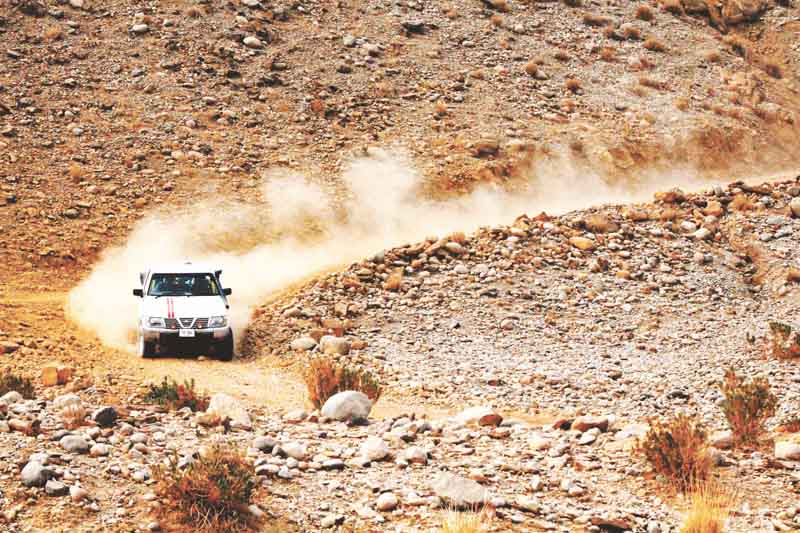

For a few days, the nights in the district suddenly come alive. People gather from all over, some even from outside the country, to take part in the largest motor rally of the country; 220 kilometres of unforgiving terrain, of sand and dunes, of mountains and rocks, of rivers and streams.


The drivers take on nature at its harshest but, sitting behind the wheels of machines weighing several tons, they are well prepared. And so man and nature go head on; miracles of engineering against the elements of nature.
Preparations
Some drivers start to arrive a week in advance and others follow soon after. Once there, the drivers stay in large tents; preparing for the race during the day, huddling around large bonfires during the night.
“We arrive early so that we can take a look at the track beforehand,” said Hozaifa Hashim, the co-driver of eventual category A — the rally car equivalent to heavyweight — winner Zafar Magsi. Co-drivers sit next to the driver during the rally; they are navigators, mechanics, and (because they must keep the driver alert if he starts falling asleep) alarm clocks during the race.
“We use the time to read the map and mark out all the potentially dangerous points. This helps us during the race as we are able to warn the drivers beforehand so that they can slow down or proceed with caution.”

PHOTO: ADEEL ASAD

However, the track is not the only thing the co-drivers concentrate on. “We study the cars as well so that we are able to prevent the car from breaking down during the race,” added Hashim.
A day before the race, the drivers take part in a qualifying round on a small improvised track to determine which driver will go first and the order of the following pack. “Since everyone is racing against time, the only advantage that the qualifying round gives is that the first driver gets what is known as a ‘virgin track’. From there on, the track deteriorates as more and more drivers use it so it becomes harder,” explained Luqman, a regular feature at the Jhal Magsi rally who opted not to participate this year. “So it is not as important as it may be in other motorsports, such as Formula One.”
The race is delayed
The rally began nearly a decade ago. It was the brainchild of three friends around a bonfire, but there was to be no perfect story to mark the rally’s 10th anniversary. Nature, ever powerful, spoilt the party. A thick fog descended on the track and the race had to be delayed, and subsequently halved from 220 kilometres to 119.

PHOTO: HANIF BHATTI

PHOTO: HANIF BHATTI
At dawn, the locals gathered around the track, some on dunes, some on small rocky cliffs, impatiently waiting for the first car to arrive; some bit off big chunks of sugar cane, others with yellow mouths and red eyes smoked hashish to pass the time. “We look forward to this time of the year,” said Mehboob, a spectator. Others gathered around him, most of them holding Kalashnikovs, a common practice in these parts. “Our nawab is participating so we hope he wins.”
With no roads, the nawabs here have their mighty cars, the poor have their famished donkeys and cows; and to each their own beast. In colourful clothes, the locals stand impatiently, shuffling from one foot to the other so that they don’t freeze. But it would still be a few hours before they get a glimpse of the first car.
And they’re off!
Once the fog cleared, the cars are asked to leave one after the other at the starting line in the order decided by the qualifying round.
After a delay of a couple of hours, the chequered flag is waved for the first driver, Ronnie Patel, and the rally begins.
All across Jhal Magsi people with walkie-talkies and cell phones inform each other in hushed whispers, “Ronnie nikal gaya, Ronnie nikal gaya” — Ronnie has left, Ronnie has left.

PHOTO: HANIF BHATTI

PHOTO: YASIR NISAR
Those gathered away from the starting line look at the horizon in anticipation, searching for the first tell-tale trail of sand that Ronnie will be leaving in his wake, the others following suit.
“Three cars have crossed the Mula River,” crackles the radio of one of the onlookers near the finish line. Sure enough, less than 10 minutes later, the first clouds of sand cover the horizon.
Someone points at it. A murmur runs through the crowd, an excited flurry of movement follows as the onlookers climb onto high vantage points to try and get a glimpse of Ronnie’s customised silver 4,300cc V8 Hilux Vigo.
Instead, it is Sarfaraz Dhanji’s white Nissan Patrol that comes racing through a corner. Confused, they look at each other. Right on cue, one of the walkie-talkies crackles, “Ronnie was involved in an accident with another car,” says the voice on the other end. “His car is totaled, he is out.”

Those gathered at the finish line rush to Dhanji to congratulate him on finishing the race. Some peer inside to see how the driver and co-driver are doing; others are more concerned with the damage to the car.
Fat wallets and brave souls
Nauman Siranjam’s category B silver Vigo follows soon after, completing the course in just over 1 hour 20 minutes; the fastest time recorded on the day. “The highest speed we reached was 153km/h but those in category A can reach much higher speeds,” said Saad Tariq, Siranjam’s co-driver, tired and barely able to speak. “There were times when we couldn’t see a thing due to all the sand thrown up by the car in front of us, but racing against time, we had to put the pedal to the metal even when driving blind. Thankfully, we emerged relatively unscathed.”

Others are not always as lucky. Asad Khuhro, another racer, almost wrecked his car when he nearly ended up in a ditch close to the final curve, but recovered well to finish second in category A; missing out on first by just seven seconds to Zafar Magsi.
Even without the poor visibility, the track is dangerous. In a few places the two-ton monsters jump in the air for a few seconds. Trapped inside an unforgiving metal cage, the drivers have little room for error.
Toying so brashly with such peril is not for the weak-hearted, but neither is it for the shallow-pocketed. The cars are expensive and become doubly so when they are customised; in which case they are placed in the ‘prepared’ categories, while the other cars are in the ‘stock’ categories — divided by engine power. Several of them break down on the track, adding to the already high costs.
“Many of the cars get busted on the way,” added Tariq. “Either their engines seize, or they suffer some other problem. That is why this is such an expensive sport; not only does it take a lot to prepare the cars for the rally but the repair cost after it is quite steep as well.”
The guns of Jhal Magsi
Above the considerable roar of the engines in the distance, one hears gunfire. Like a lethal version of Morse code, a celebratory volley on seeing one of the local heroes reach the finish line is followed by an answer from some other end. Once it starts, the aerial firing continues late into the evening either as both exhilarated celebration and bruised ego.
Only after the sun had sunk behind the mountains, long after the final car crossed the finish line, did the echoes of gunfire stop.
The previous night had been black; as black as the bands wrapped around the arms of all the drivers and co-drivers in respect to the recent Peshawar tragedy. But tonight the village gathered at the rally’s closing ceremony, eager to see the winners receive their awards and take part in the festivities.

Here they celebrated late into the night, until the lights went out and the wild dogs started to howl at the moon.
And as the night consumed the valley and the mountains, the monsters scattered and dispersed after delirium and despair, drugs and prayers, gunfire and finally silence. Until next year...
Taha Anis is a subeditor on The Express Tribune Sports desk.
Published in The Express Tribune, Sunday Magazine, January 11th, 2015.


1732538123-0/BeFunky-collage-(90)1732538123-0-165x106.webp)

1732536148-0/ariana-(1)1732536148-0-165x106.webp)












COMMENTS
Comments are moderated and generally will be posted if they are on-topic and not abusive.
For more information, please see our Comments FAQ